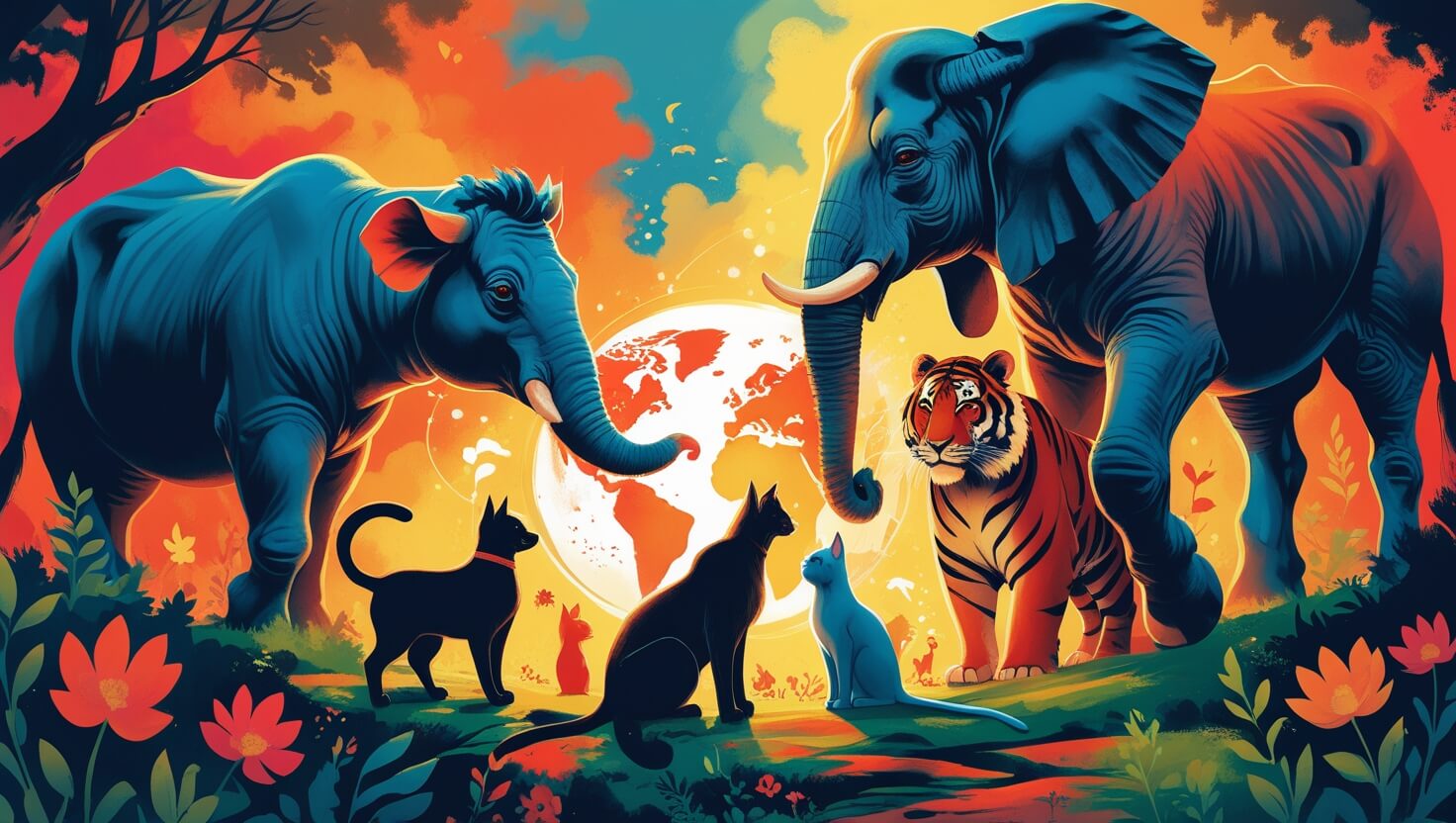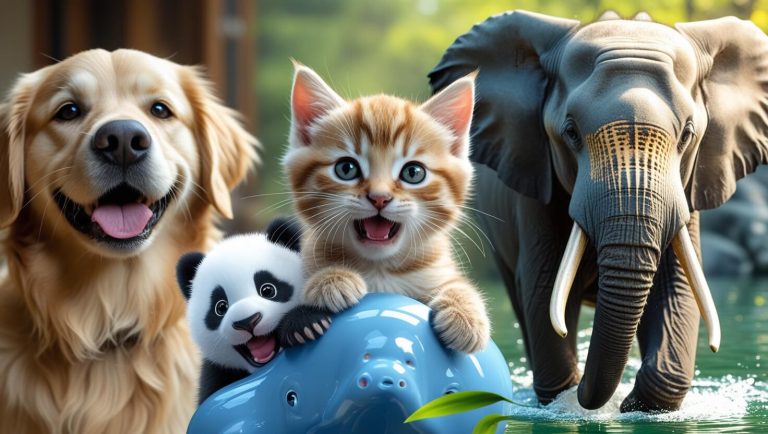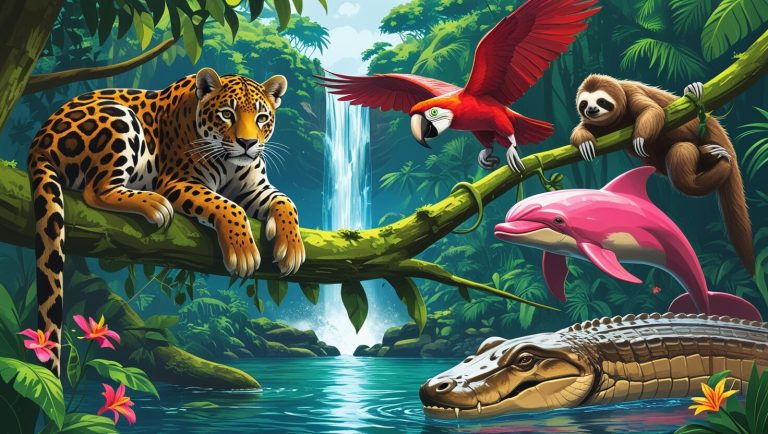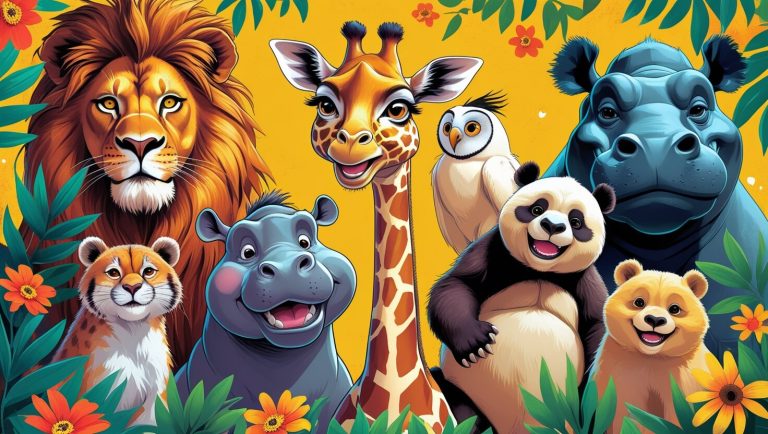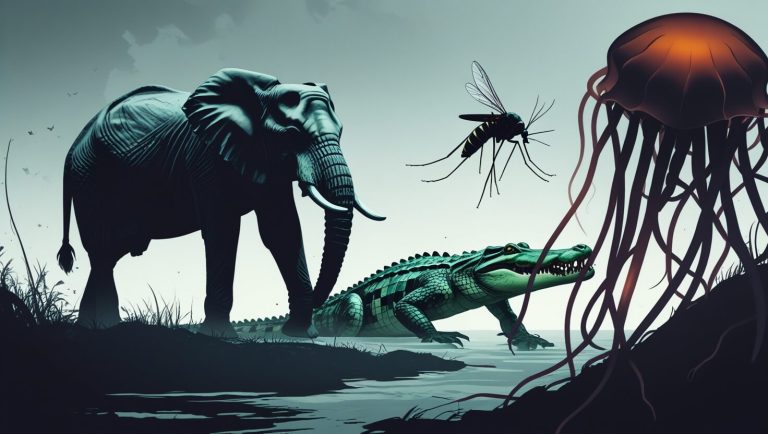Top 10 Most Popular Animals in the World: An In-Depth Look
From the majestic lion to the playful dolphin, animals hold a special and powerful place in our hearts. Humans have a unique and innate connection to the animal kingdom, fueled by a complex mix of admiration, empathy, and companionship.
We see ourselves reflected in their loyalty, their struggles, and their triumphs, and our relationship with them has shaped our societies, cultures, and even our own evolution. But in a world filled with countless species, what makes some animals stand out as truly “popular”? Is it their striking appearance, their role in our daily lives, or their presence in the media we consume?
In this comprehensive blog post, we will delve deep into the concept of animal popularity, moving beyond simple affection to explore the criteria that define an animal’s global appeal. We will then embark on an extensive countdown of the top 10 most beloved animals across the globe, providing a detailed look at the history, science, and cultural impact of each. Finally, we will reflect on the psychological and emotional reasons behind our deep-seated connection to the animal world. Get ready to embark on a fascinating journey through the hearts and minds of humanity’s favorite creatures.
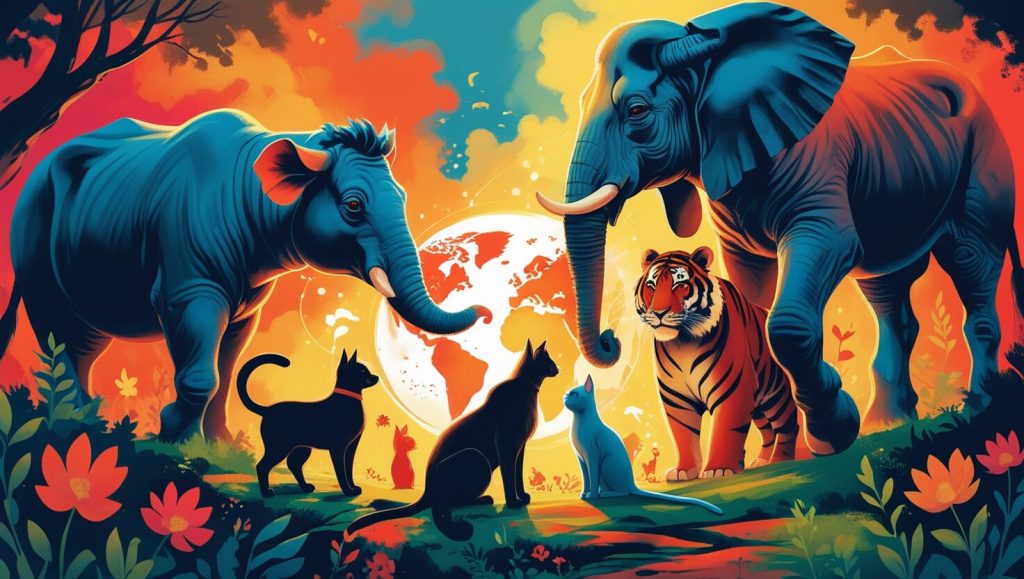
Understanding the Criteria for Popularity
An animal’s popularity is far more nuanced than just its number of owners. It’s a complex, multi-faceted phenomenon shaped by a combination of factors that resonate with different aspects of the human experience. These criteria act as a lens through which we can understand why certain species capture our collective imagination.
- Internet Virality and Memes: In the modern era, the internet has become a powerful arbiter of popularity. A cat’s silly expression or a dog’s heroic rescue can become a global sensation overnight. Viral videos, memes, and social media trends elevate animals to celebrity status, transforming them into digital icons. This instant, shared experience creates a sense of collective affection that transcends geographical boundaries and cultural differences. The appeal lies in their ability to provide simple joy, humor, and a momentary escape from the complexities of daily life.
- Pop Culture Influence: Animals are more than just background characters in our stories; they are often central figures. Their roles in movies, TV shows, books, and video games can turn them into beloved, archetypal icons. Think of the brave lion, the wise owl, or the clever fox. These characters shape our perception of their real-life counterparts, endowing them with personality traits and emotional depth that make them more relatable and endearing. This form of storytelling creates a powerful and lasting emotional bond that begins in childhood and lasts a lifetime.
- Pet Ownership Statistics: The most tangible measure of an animal’s popularity is its presence in our homes. The number of households that own a particular type of pet is a direct indicator of its role as a companion. Pet ownership provides us with unconditional love, a sense of purpose, and numerous health benefits, from reduced stress to increased physical activity. These animals are integrated into the fabric of our families, becoming cherished members and providing a constant source of comfort and joy.
- Conservation Awareness and Symbolism: An animal’s endangered status can paradoxically increase its popularity. The plight of a species facing extinction, such as the panda or the tiger, often galvanizes global attention and sympathy. Organizations like the World Wildlife Fund (WWF) have successfully used charismatic megafauna as symbols for broader conservation efforts. This awareness transforms the animal from a simple creature into a powerful symbol of nature’s fragility and our responsibility to protect it, fostering a sense of shared purpose and emotional investment.
- Cultural and Spiritual Significance: Many animals hold deep roots in the mythology, folklore, and religion of various cultures. They can symbolize virtues like strength, wisdom, or fertility, or serve as spiritual guides and deities. The elephant’s sacred status in some Asian religions, the lion’s representation of royalty in Europe, or the wolf’s complex role in Native American traditions are all examples of how cultural narratives have shaped our reverence and affection for specific animals over centuries.
Top 10 Most Popular Animals
| Rank | Animal | Type | Habitat | Key Traits | Conservation Status |
|---|---|---|---|---|---|
| 1 | Dog | Domestic | Global (households) | Loyal, intelligent, diverse breeds | Not endangered |
| 2 | Cat | Domestic | Global (households) | Independent, graceful, playful | Not endangered |
| 3 | Lion | Wild | African savannas | Majestic, social, powerful roar | Vulnerable (~20,000 left) |
| 4 | Elephant | Wild | African/Asian savannas, forests | Intelligent, emotional, largest land animal | Endangered (~600,000 left) |
| 5 | Tiger | Wild | Asian forests, grasslands | Beautiful, solitary, powerful | Endangered (~3,900 left) |
| 6 | Dolphin | Wild | Oceans worldwide | Playful, intelligent, acrobatic | Varies by species |
| 7 | Panda | Wild | Chinese mountains | Adorable, black-and-white coat | Endangered (~1,800 left) |
| 8 | Horse | Domestic/Wild | Global (farms, wild in Mongolia) | Graceful, strong, fast | Not endangered |
| 9 | Bird | Wild/Domestic | Global (varies) | Colorful, diverse, some mimic speech | Varies (some species endangered) |
| 10 | Monkey | Wild | Forests, jungles (Africa, Asia, Americas) | Intelligent, social, human-like | Varies (some species endangered) |
The Top 10 Most Popular Animals in the World
Now, let’s take an in-depth look at the animals that have truly captured the hearts of people across the globe.
1. Dogs
It is with little surprise that dogs take the top spot. Their enduring title as “man’s best friend” is a testament to the thousands of years of shared history and companionship. The science behind this bond is fascinating; studies have shown that the physical and emotional act of interacting with a dog releases oxytocin, the “love hormone,” in both the human and the animal. This creates a powerful, mutually beneficial relationship rooted in trust and affection.
Throughout history, dogs have served in countless roles, from loyal hunting partners and protectors to working animals on farms and in search-and-rescue teams. Their intelligence and trainability have allowed them to adapt to an incredible array of tasks, making them indispensable allies. Globally, breeds like the Labrador Retriever, German Shepherd, and Golden Retriever consistently rank among the most popular, cherished for their friendly temperaments and adaptable nature. In the digital age, dog influencers like Jiffpom and Doug the Pug have amassed millions of followers, creating a new form of celebrity that proves their appeal is stronger than ever.
Fun Fact: A dog’s sense of smell is estimated to be 10,000 to 100,000 times more sensitive than a human’s, and they can even be trained to detect diseases like cancer in humans.
2. Cats
Following closely behind in the hearts of many are cats. Their domestication is believed to have begun approximately 9,500 years ago in the Near East, making them one of the oldest domesticated animals. Their independent yet affectionate nature is a key part of their charm. While they may not offer the same boisterous companionship as dogs, their quiet purrs and gentle headbutts are a source of immense comfort.
The internet, in particular, has become a veritable cat kingdom. From the Grumpy Cat to viral videos of cats doing hilarious things, they have cemented their status as the unofficial mascots of the web. This shared, global humor has created a unique form of collective appreciation. In pop culture, cats have been revered for centuries, from the sacred cats of ancient Egypt to iconic characters like Garfield, the Cheshire Cat, and the sophisticated feline from Puss in Boots. Breeds like the Ragdoll, Maine Coon, and British Shorthair are celebrated for their striking appearances and unique personalities. Statistically, cats are one of the most common household pets in the world, with a slightly larger population than dogs globally.
3. Tigers
As a symbol of raw power, beauty, and untamed wilderness, the tiger commands a profound level of respect and admiration. There are several subspecies, including the Bengal, Indochinese, and Siberian tigers, each with its own unique characteristics and habitat. These magnificent creatures are featured prominently in mythology and folklore, particularly in Asian cultures where they symbolize strength, courage, and royalty. In Chinese mythology, the tiger is one of the four mythological creatures and represents the cardinal direction West.
Unfortunately, their beauty has also made them a target for poaching for their fur and body parts, which are used in traditional medicines. This has led to their status as an endangered species, sparking a massive global conservation effort. Organizations like the WWF have worked tirelessly to combat poaching and protect their shrinking habitats. Tigers are also popular in logos for sports teams and brands, and their iconic stripes have graced the silver screen in movies like Disney’s The Jungle Book and Life of Pi, further cementing their place in our cultural consciousness.
4. Elephants
Revered for their incredible intelligence, emotional depth, and complex social structures, elephants are truly majestic. There are two main species: the African elephant and the Asian elephant, each with distinct features. African elephants are larger and have bigger ears, while Asian elephants are smaller and have smaller ears. Elephants have a profound cultural and religious significance in many parts of the world, especially in India and Thailand, where they are seen as symbols of wisdom, good fortune, and strength.
Their family bonds are legendary, with females living in close-knit matriarchal herds and displaying complex behaviors such as mourning their dead. However, they face severe threats from poaching for their ivory and from habitat loss due to human encroachment. This has made them a focal point for global conservation and animal welfare organizations. Their gentle nature and complex social structures also make them a popular subject for ecotourism and documentaries, where their intelligence and emotional depth are often on full display.
5. Dolphins
Playful, intelligent, and social, dolphins are a favorite of ocean lovers. Their friendly demeanor and acrobatic displays have made them stars of marine shows and nature documentaries, captivating audiences with their grace and agility. Their intelligence is well-documented, with scientists noting their ability to solve complex problems, use tools, and even recognize themselves in a mirror, a sign of self-awareness.
Their advanced communication skills and use of echolocation—a sophisticated sonar system—continue to fascinate scientists. Dolphins are often featured in myths and legends as helpers of sailors and symbols of harmony between humanity and nature. They also serve as a powerful symbol for ocean conservation movements, highlighting the importance of protecting our seas from pollution and other threats. However, their popularity in shows has also led to a debate around the ethics of keeping them in captivity.
6. Horses
Horses have been indispensable to human civilization for millennia. Their domestication dates back to around 4000 B.C. in the Eurasian Steppes, and they have played a pivotal role in shaping history. From transport and agriculture to warfare and exploration, they have been our partners in progress. This long and intimate partnership has forged a deep emotional bond between humans and horses, one built on trust and mutual respect.
Today, horses are popular in horse racing, equestrian sports, and therapeutic riding. They are celebrated for their grace, power, and loyalty. Popular breeds like the Arabian, the Thoroughbred, and the Friesian are cherished for their unique characteristics and noble lineage. The horse’s role in our past and present makes it one of the most cherished and iconic animals in the world, symbolizing freedom, power, and partnership.
7. Pandas
With their black-and-white coats, gentle demeanor, and a seemingly perpetual air of shyness, pandas are universally adored for their cuteness. They have become the global symbol for endangered species conservation, with the World Wildlife Fund (WWF) adopting the panda as its logo in 1961. The story of their conservation is a testament to global cooperation. Through habitat protection and extensive breeding programs, the panda’s status was upgraded from “endangered” to “vulnerable” in 2016, a rare and heartwarming success story in the world of conservation.
Their presence in global zoos is often part of “panda diplomacy,” a practice where China lends pandas to other countries as a gesture of goodwill. These beloved animals bring in millions of visitors and serve as a powerful reminder of wildlife protection efforts. In Chinese culture, the panda symbolizes peace and good luck, further enhancing its positive image.
8. Lions
The lion, often called the “King of the Jungle” despite living in the savanna, is a powerful and iconic symbol of courage, royalty, and strength. The lion’s social structure, known as a pride, is unique among felines and is a source of fascination. This status has made it a popular character in literature and cinema, most famously in Disney’s The Lion King. The lion’s image is also used extensively in heraldry and national symbols around the world, representing strength, nobility, and leadership.
As apex predators in the African savanna, lions play a crucial role in maintaining the health of their ecosystem. However, they face significant threats from habitat loss and human-wildlife conflict. Their conservation status is a major global concern, and they are a top attraction for wildlife safaris and ecotourism, where their majesty can be observed in their natural habitat.
9. Penguins
The charming waddle, formal appearance, and unique group behaviors of penguins make them irresistible. There are 18 different species of penguins, ranging from the tiny Little Penguin to the Emperor Penguin, the largest of the species. Their popularity skyrocketed with animated movies like Happy Feet and Madagascar, which brought their endearing personalities to a global audience.
Their unique adaptations to cold environments, such as their waterproof feathers and dense bone structure, are a marvel of natural evolution. Their dedicated parenting and monogamous mating habits are also a source of fascination. However, these flightless birds are highly vulnerable to climate change, which threatens their food sources and breeding grounds. This makes them a poignant symbol for the fight against global warming and a favorite of nature documentaries.
10. Rabbits
Rounding out the list are rabbits, an animal synonymous with cuteness, fertility, and luck. Their small size, soft fur, and gentle nature have made them popular pets for centuries. Their presence in children’s literature, from Beatrix Potter’s Peter Rabbit to the Easter Bunny, has made them a beloved figure from a young age, imbuing them with a sense of innocence and wonder.
Rabbits hold significant cultural relevance in many societies. They are often symbols of new beginnings and spring, most notably associated with the Easter holiday. In Chinese mythology, the rabbit is one of the 12 animals of the Chinese Zodiac, representing cleverness and good luck. While their quick reproduction rate can have a negative ecological impact in regions where they are not native, their quiet and gentle nature makes them cherished companions and a consistent presence in our stories and lives.
Honorable Mentions
While they may not have made the top 10, other animals that deserve a shout-out for their popularity and impact include:
- Koalas: Adored for their sleepy, cuddly appearance and their status as a unique symbol of Australia’s wildlife.
- Wolves: Symbols of wilderness, pack loyalty, and often misunderstood creatures that have a complex and fascinating role in folklore and conservation.
- Owls: Mysterious and wise creatures often associated with knowledge and magic in many cultures.
- Monkeys: Known for their playful and intelligent antics, they often remind us of our own evolutionary history.
- Foxes: Admired for their cleverness, sleek appearance, and their complex portrayal in fables and myths.
Why Do We Love These Animals So Much?
Our deep affection for animals is not a random occurrence; it’s a fundamental part of the human experience. Psychologists and biologists have long sought to understand the reasons behind this connection, and a few key theories have emerged.
Evolutionary Psychology and Biophilia: The concept of biophilia, first coined by Erich Fromm and later popularized by Edward O. Wilson, suggests that humans have an innate, evolutionary-based need to connect with other forms of life. Our ancestors’ survival depended on their ability to understand and interact with the natural world, and this connection is still hardwired into us today. Seeing animals brings us a sense of peace and belonging, reminding us of our place in the larger ecosystem.
Media Influence and Anthropomorphism: Movies, books, and documentaries play a crucial role in shaping our emotional bonds with animals. By giving animals human-like traits and backstories, a concept known as anthropomorphism, storytellers make them relatable and emotionally resonant. We see a lion’s family struggles and relate to them, or a penguin’s quest for love and feel a sense of shared experience. This storytelling helps us form powerful connections with animals we may never encounter in real life.
The Power of Storytelling: Beyond media, we humanize animals in our daily interactions, telling stories about our pets’ personalities and quirks. This storytelling turns them from simple companions into fully-fledged members of our families and communities, deepening our emotional investment.
Conservation Empathy: The plight of endangered species inspires a powerful form of empathy. When we see an animal struggling for survival, it taps into our protective instincts and our desire to do good. This feeling of responsibility drives us to support conservation efforts and advocate for change, making the act of loving an animal a moral and ethical one.
FAQs Section of Top 10 Most Popular Animals
u003cstrongu003eWhy are dogs considered the most popular animal in the world?u003c/strongu003e
Dogs are known for their loyalty, intelligence, and companionship. They’ve been humans’ closest friends for thousands of years and serve in roles such as therapy, security, and assistance animals. Their emotional connection with humans makes them universally loved.
u003cstrongu003eWhat makes cats so popular on the internet?u003c/strongu003e
Cats are naturally curious, quirky, and sometimes hilariously unpredictable — which makes them perfect for short, viral content. Their funny behaviors, dramatic expressions, and independent attitude have made them internet icons.
u003cstrongu003eAre wild animals like tigers and lions more popular than domestic pets?u003c/strongu003e
While domestic pets like dogs and cats are loved for their companionship, wild animals like tigers and lions are admired for their power, beauty, and mystery. Both types hold popularity, but for very different reasons — one for closeness, the other for awe and admiration.
u003cstrongu003eWhy are pandas so special to people worldwide?u003c/strongu003e
Pandas are adored for their cute appearance and calm nature. As an endangered species, they also symbolize conservation efforts globally. Their playful behavior and gentle looks make them a favorite among people of all ages.
u003cstrongu003eWhich animal is the most loved by children?u003c/strongu003e
Rabbits and dolphins are often among the most loved animals by children. Rabbits are soft, small, and often featured in children’s books and cartoons, while dolphins are friendly, playful, and appear in many fun ocean-themed stories and movies.
Conclusion
From the loyalty of a dog to the majestic beauty of a tiger, animals are an integral part of our world and imagination. They bring us joy, teach us about empathy, and inspire us to protect the planet we all share. Our relationships with these creatures are a reflection of our own humanity, showing our capacity for love, compassion, and connection.
The popularity of these top 10 animals is not just a matter of chance; it is a testament to their deep-rooted significance in our lives, cultures, and emotional landscapes. Whether we see them as companions, symbols of power, or icons of conservation, they shape our world in profound and lasting ways.
Now it’s your turn. What animal is your favorite, and why does it hold a special place in your heart?
judi bola

Rony Junior is a lifelong animal lover who’s happiest with muddy paws on the couch and fur on their clothes. From curious cats to loyal dogs and everything in between, they write about the joy, challenges, and quirks of living alongside animals. When not blogging, you can find them at the local shelter, giving belly rubs and making new four-legged friends.

